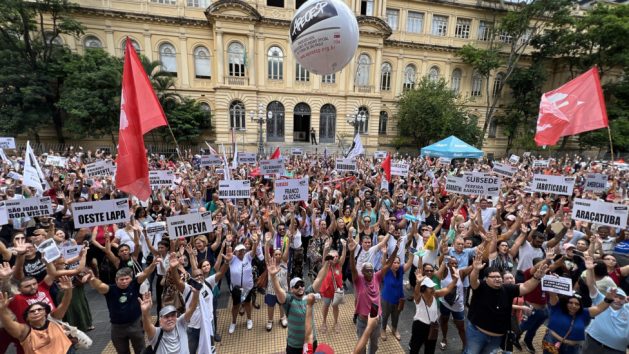Secondary Education Is a Bottleneck in Brazil
Secondary Education Is a Bottleneck in Brazil Global Issues


Teachers in Brazil Demand Better Working Conditions
By Mario Osava (Rio de Janeiro)
Monday, April 15, 2024
Source: Inter Press Service

Introduction
Alice went for eight weeks without Portuguese language classes after starting her first year of high school on Feb. 5 in this Brazilian city. Her chemistry teacher taught only two classes and disappeared. But the worst part is the classroom without air conditioning in the heat of more than 35 degrees Celsius some days during the southern hemisphere summer.
Challenges in Public Education in Brazil
Alice’s public school in a central neighborhood of Rio de Janeiro, with more than 500 students, illustrates the conditions of public education in Brazil, with poorly paid teachers and the resulting poor work attendance, as well as precarious infrastructure and other problems.
It is precisely in secondary education – the last three years of high school after nine grades of primary and middle school – that the biggest bottleneck in Brazilian education is found, according to an assessment agreed on widely by experts. The first nine years are for students up to the age of 14 and the last three years for students between the ages of 15 and 17.
Reform of Secondary Education Law
Since Mar. 27, the Senate has been discussing a reform of the New Secondary Education Law, which came into force only two years ago. The government, in office since January 2023, proposed the modifications whose key points were already approved by the lower house of Congress.
Brazil is thus trying to overcome the shortcomings in education that have placed the country among the lowest ranked in comparative assessments, such as the Program for International Student Assessment (PISA), which studies 81 countries.
Key Points of the Reform
The new reform raises from 1,800 to 2,400 the number of hours to be dedicated during the three years of high school to compulsory subjects such as mathematics, natural and human sciences, and the Portuguese, English and Spanish languages.
It also provides for the extension of full-time education to a minimum of seven hours per day, and in technical-vocational schools as well.
In full-time primary and secondary institutions, students are at school for at least seven hours a day, attend regular classes in the morning and extracurricular activities, such as technical courses, sports or special subjects in the afternoon, or vice versa.
In addition, they receive two or three meals at school and in some cases can take a shower there – an attraction for students from low-income families in a country marked by huge social inequalities.
Curbing the School Dropout Rate
The government also created the “pe de meia” program, which in Brazil means savings. It offers 2,000 reais (400 dollars) per year, divided into 10 monthly installments, to high school students whose families are poor and are registered in the government’s Unified Social Assistance Registry. To receive it, they must demonstrate at least 80 percent school attendance.
The aim is to curb the dropout rate, which is higher in secondary education than in primary or middle school.
In 2023, the number of students who dropped out of school totaled 480,000, according to the Ministry of Education’s school census, released on Apr. 2.
In this country of 203 million people, of the adolescents and young people aged 15 to 29, nine million are out of school and have not completed high school, according to 2023 data from the Brazilian Institute of Geography and Statistics (IBGE).
Expanding Full-Time Education
“The statistics show a challenging scenario, with many students lagging behind because they flunk or drop out of school. In addition to the ‘pe de meia’ program and other measures, systemic policies are needed, such as adequate infrastructure, teachers and full-time education,” said Natália Fregonesi, coordinator of Educational Policies at the non-governmental organization Todos pela Educação (Everyone for Education).
Full-time schools are an efficient model, as they create a different relationship between students and schools, offer other subjects in addition to the regular curriculum, help youngsters think more clearly about their future, and give students a leading role, in addition to having full-time teachers, the expert told IPS by telephone from São Paulo.
The idea is to increase the number of full-time schools, which already exist throughout the country, but in a very unequal manner. While in the state of Pernambuco, in the impoverished Northeast region, 66.8 percent of students are in full-time education, in the Federal District, where Brasilia
SDGs, Targets, and Indicators
SDGs Addressed or Connected to the Issues Highlighted in the Article:
- SDG 4: Quality Education
- SDG 5: Gender Equality
- SDG 8: Decent Work and Economic Growth
- SDG 10: Reduced Inequalities
Specific Targets Based on the Article’s Content:
- Target 4.1: By 2030, ensure that all girls and boys complete free, equitable, and quality primary and secondary education leading to relevant and effective learning outcomes.
- Target 4.5: By 2030, eliminate gender disparities in education and ensure equal access to all levels of education and vocational training for the vulnerable, including persons with disabilities, indigenous peoples, and children in vulnerable situations.
- Target 8.5: By 2030, achieve full and productive employment and decent work for all women and men, including for young people and persons with disabilities, and equal pay for work of equal value.
- Target 10.2: By 2030, empower and promote the social, economic, and political inclusion of all, irrespective of age, sex, disability, race, ethnicity, origin, religion, or economic or other status.
Indicators Mentioned or Implied in the Article:
- Number of hours dedicated to compulsory subjects in high school (Indicator for Target 4.1)
- Proportion of students in full-time education (Indicator for Target 4.1)
- Number of students who drop out of school (Indicator for Target 4.1)
- School attendance rate (Indicator for Target 4.1)
- Number of students enrolled in technical courses (Indicator for Target 4.5)
- Spending per basic education student (Indicator for Target 4.5)
- Proportion of students in full-time schools (Indicator for Target 8.5)
- Employment rate for young people (Indicator for Target 8.5)
- School dropout rate by gender (Indicator for Target 10.2)
Table: SDGs, Targets, and Indicators
| SDGs | Targets | Indicators |
|---|---|---|
| SDG 4: Quality Education | Target 4.1: By 2030, ensure that all girls and boys complete free, equitable, and quality primary and secondary education leading to relevant and effective learning outcomes. | – Number of hours dedicated to compulsory subjects in high school – Proportion of students in full-time education – Number of students who drop out of school – School attendance rate |
| SDG 5: Gender Equality | Target 4.5: By 2030, eliminate gender disparities in education and ensure equal access to all levels of education and vocational training for the vulnerable, including persons with disabilities, indigenous peoples, and children in vulnerable situations. | – Number of students enrolled in technical courses – Spending per basic education student |
| Target 10.2: By 2030, empower and promote the social, economic, and political inclusion of all, irrespective of age, sex, disability, race, ethnicity, origin, religion, or economic or other status. | – School dropout rate by gender | |
| SDG 8: Decent Work and Economic Growth | Target 8.5: By 2030, achieve full and productive employment and decent work for all women and men, including for young people and persons with disabilities, and equal pay for work of equal value. | – Proportion of students in full-time schools – Employment rate for young people |
| SDG 10: Reduced Inequalities | Target 10.2: By 2030, empower and promote the social, economic, and political inclusion of all, irrespective of age, sex, disability, race, ethnicity, origin, religion, or economic or other status. | – School dropout rate by gender |
Behold! This splendid article springs forth from the wellspring of knowledge, shaped by a wondrous proprietary AI technology that delved into a vast ocean of data, illuminating the path towards the Sustainable Development Goals. Remember that all rights are reserved by SDG Investors LLC, empowering us to champion progress together.
Source: globalissues.org

Join us, as fellow seekers of change, on a transformative journey at https://sdgtalks.ai/welcome, where you can become a member and actively contribute to shaping a brighter future.







